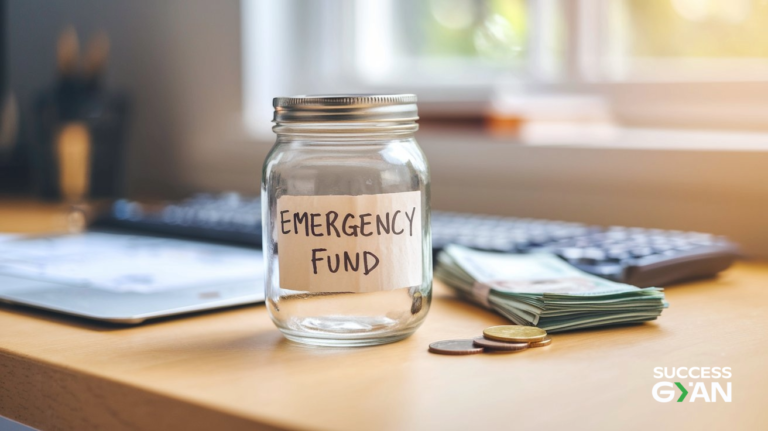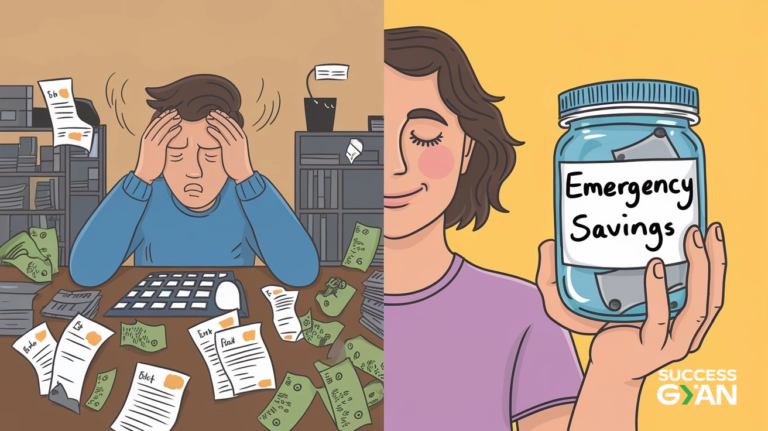

Emergency Fund: How much should you have | How to calculate?

How to Calculate Your Emergency Fund?
Based on the survey ‘India’s money habits’ in 2023, it was reported that 75% of Indians don’t have an emergency fund. The survey said people can default on EMIs in case of a sudden job loss.
An emergency fund or a contingency fund is a personal financial budget set aside to cover expenses during unexpected situations. You can use an emergency fund in situations like job loss, medical emergencies, or income reduction. Life is unpredictable, and living is expensive. So, having an emergency fund is crucial for financial stability.
If you want to build an emergency fund, this blog will help you.
Why is an emergency fund important?
Remember COVID-19? Businesses shut down, and people lost their jobs. Life forward was uncertain during those days as people lost their only source of income. People who had an emergency fund were able to take care of their expenses without much worry. People who didn’t have an emergency fund had to borrow money or struggled to make ends meet. Even people who suffered from the disease struggled to pay their medical bills.
An emergency fund helps you avoid debt during a crisis and provides peace of mind. It can prevent you from relying on loans or credit cards. It will help you during medical emergencies. If you are a working professional, it will keep you financially secure and help you cover basic needs in case of unemployment.
An emergency fund ensures you can meet essential needs without compromising long-term financial goals. It is ideal to build an emergency fund to cover 3 to 6 months of your living expenses.
How much should I save in an emergency fund?
There are so many factors to check while saving for an emergency fund. The size of your emergency fund will vary depending on your lifestyle, monthly expenses, income, number of dependents, etc. It is a thumb rule to save at least 3 to 6 months’ expenses for emergencies. You will learn more about it in the upcoming sections.

Monthly Expenses
Fixed Expenses:
Fixed expenses are predictable, and recurring costs that remain constant every month. So, it is essential to include fixed expenses when calculating emergency funds. They are long-term commitments.
Fixed expenses include rent, electricity, water and gas bills, insurance premiums, education fees, subscriptions, taxes, internet, phone, and maintenance charges.
Variable Expenses:
Variable expenses are costs that fluctuate based on your usage. These expenses can vary due to personal choices or external factors. Variable expenses are mostly unpredictable, as they change from month to month.
Variable expenses include groceries, which vary depending on your eating habits or price changes. Other examples include transportation, clothing, and healthcare not covered by insurance. Emergency veterinary costs can even come up if you are a pet owner. The urgent repairs in your house can also be considered a variable cost.
In times of financial difficulty, variable expenses like entertainment or dining out can be reduced to protect your emergency fund. These variable expenses can impact budgeting, so it’s important to track them.
Debt Payments:
Our income may not always suffice for our lifestyle. It is common for people to take loans or use credit cards for their expenses. People also use EMIs to buy things they want.
When creating an emergency fund, keep in mind that debt payments are also a financial obligation. It should be prioritized to avoid penalties or interest. Paying off your debt is essential for maintaining a good credit score. However, it can also limit the disposable income available for essential needs. During emergencies, debt can be a burden for you. So try to clear off all your debts when you can.
Remember that in emergencies, an emergency fund can prevent the need for new loans, reducing future debt burdens. It is advisable to avoid using an emergency fund to pay off non-essential debt and keep those savings for genuine emergencies.
Coverage Period
The coverage period should reflect your circumstances, such as job stability, family situation, and monthly expenses. In India, the time to find a new job can vary based on industry and location. A job search usually takes 3 to 12 months. Someone working in a specialized role could face a longer search time due to fewer job vacancies and higher competition.
If you work a job and have no immediate alternate income, you need a longer coverage period of 6 to 9 months to be safe. Medical expenses can quickly deplete savings, requiring a recovery period of 6 to 12 months to regain financial stability. A longer coverage period is also relevant for freelancers or small business owners whose income can fluctuate.
If you have more than one income stream, a 3-month emergency fund may be suitable. You can review your coverage period based on changes in your financial situation, such as after a salary increase or relocating to a more expensive location.
Other Variables
Current Savings:
If you already have some savings, you can factor that into your goal. For example, your monthly expense is Rs. 50,000, and your target is to save six months of expenses. If you already have ₹1 lakh saved, you only need to save an additional ₹2 lakh.
Monthly Income:
Your monthly income plays a vital role in determining the size of your emergency fund. Higher monthly income provides more flexibility in building your emergency fund by allocating a larger portion of your income to savings each month.
Interest Rate on Savings:
The interest rate on your savings impacts the growth of your emergency fund. In India, various savings options, such as fixed deposits (FDs) or high-interest savings accounts, offer different interest rates. A higher interest rate means your money can grow faster, helping you reach your savings goal sooner. Choose a high interest rate option to reach your goals faster.
Inflation Rate:
Inflation in India can reduce the purchasing power of your savings. You have to consider the inflation rate when building an emergency fund. As prices rise, the amount you save today may not be enough to cover your future expenses. For example, if the inflation rate is 6% and your emergency fund does not grow at a comparable rate, the value of your fund decreases over time.
5 Tips to Grow Your Emergency Fund Faster
Increase Your Savings Rate:
Increase your contributions to your emergency fund whenever you receive extra income. If you receive a bonus or an incentive, you can use a part of it to save for your emergency fund. This will accelerate your savings growth and help you reach your target faster.
Reduce Unnecessary Expenses:
Reduce unnecessary spending and use the money to save for your emergency fund. This way, you can maximize your contributions without impacting your essential expenses.
Use High-Interest Savings Accounts:
Open a high-yield savings account with competitive interest rates to ensure your emergency fund grows faster.
Take part in Savings Challenges:
Engaging in savings challenges can create a fun and motivating way to increase your savings rate.
Automate Your Savings:
Setting up automatic transfers to your emergency fund savings account ensures consistent contributions to your emergency fund. You can do it without requiring active effort.
Conclusion
Building an emergency fund is crucial to achieving financial security and peace of mind. This blog discussed the essential elements of calculating your emergency fund. You learned to assess your monthly expenses, determine a suitable target amount, and factor in your current savings and income.
Understanding the timeframe for building your emergency fund can help you set realistic goals.
Having an emergency fund can protect you from unexpected financial challenges. We encourage you to build your emergency fund today to secure your financial future.
FAQ on "Emergency Fund: How much should you have | How to calculate?"
Identify your Monthly Expenses: List all essential expenses, including rent, utilities, groceries, and transportation.
Determine the Target Fund Size: Multiply your monthly expenses by three to six months to establish your total emergency fund goal.
Example: If your monthly expenses are ₹30,000, your target fund should be between ₹90,000 and ₹180,000.
Consider Additional Factors: Adjust your target based on job stability, dependents, and health conditions that may affect your financial situation.
Set up Automatic Transfers: A part of your income will be automatically transferred to a dedicated savings account each month. This helps build your fund without needing to think about it.
Cut Unnecessary Expenses: Review your monthly budget and identify areas where you can cut back (like dining out or subscription services). This will free up more money for your emergency fund.
Set Specific Goals: Define a clear timeline for achieving your emergency fund target and break it into manageable goals.
Income: Higher income allows for larger contributions. For example, if you earn ₹50,000 a month and save ₹10,000, you’ll reach a target of ₹180,000 in 18 months. If your income is lower, the time will extend proportionately.
Savings Rate: The percentage of income saved each month influences the duration. Saving 20% of a ₹50,000 monthly salary (₹10,000) is faster than saving 10% (₹5,000).
Unexpected Gains: Tax refunds, bonuses, or gifts can help you reach your goal faster.
Here, emergencies are unexpected events that can cause financial strain.
Some situations where you can use your emergency fund:
- Medical Emergencies: Sudden illness or accident requiring immediate medical attention.
- Job Loss: Being laid off or unemployed unexpectedly, needing funds to cover expenses while seeking new employment.
- Natural Disasters: Expenses incurred due to unforeseen events like floods or earthquakes that require urgent financial resources.
Avoid spending your emergency fund on non-essential items like vacations or entertainment. Only use it for genuine emergencies or your survival. If you spend it carelessly, you will struggle during a crisis.
Examples of what not to spend it on:
- Impulse purchases
- Vacations and travel
- High-interest debt repayment
- Investments
Avoid using your emergency fund unnecessarily and cut out non-essential expenses. This helps preserve your emergency fund for when it’s really needed.
Identify your Monthly Expenses: List all essential expenses, including rent, utilities, groceries, and transportation.
Determine the Target Fund Size: Multiply your monthly expenses by three to six months to establish your total emergency fund goal.
Example: If your monthly expenses are ₹30,000, your target fund should be between ₹90,000 and ₹180,000.
Consider Additional Factors: Adjust your target based on job stability, dependents, and health conditions that may affect your financial situation.
Set up Automatic Transfers: A part of your income will be automatically transferred to a dedicated savings account each month. This helps build your fund without needing to think about it.
Cut Unnecessary Expenses: Review your monthly budget and identify areas where you can cut back (like dining out or subscription services). This will free up more money for your emergency fund.
Set Specific Goals: Define a clear timeline for achieving your emergency fund target and break it into manageable goals.
Income: Higher income allows for larger contributions. For example, if you earn ₹50,000 a month and save ₹10,000, you’ll reach a target of ₹180,000 in 18 months. If your income is lower, the time will extend proportionately.
Savings Rate: The percentage of income saved each month influences the duration. Saving 20% of a ₹50,000 monthly salary (₹10,000) is faster than saving 10% (₹5,000).
Unexpected Gains: Tax refunds, bonuses, or gifts can help you reach your goal faster.
Here, emergencies are unexpected events that can cause financial strain.
Some situations where you can use your emergency fund:
- Medical Emergencies: Sudden illness or accident requiring immediate medical attention.
- Job Loss: Being laid off or unemployed unexpectedly, needing funds to cover expenses while seeking new employment.
- Natural Disasters: Expenses incurred due to unforeseen events like floods or earthquakes that require urgent financial resources.
Avoid spending your emergency fund on non-essential items like vacations or entertainment. Only use it for genuine emergencies or your survival. If you spend it carelessly, you will struggle during a crisis.
Examples of what not to spend it on:
- Impulse purchases
- Vacations and travel
- High-interest debt repayment
- Investments
Avoid using your emergency fund unnecessarily and cut out non-essential expenses. This helps preserve your emergency fund for when it’s really needed.

Millionaire Mind Intensive is about unlocking your financial freedom and strengthening your relationship with money.
Quick Links
Contact Info
Success Gyan India LLP
S5, Thiru Vi Ka Industrial Estate,
Guindy, Chennai – 600032







